Long-Term Assessment of Morocco’s Offshore Wind Energy Potential Using ERA5 and IFREMER Wind Data
Abstract
:1. Introduction
- -
- Validation of ERA5 10 m reanalysed wind data set against the IFREMER blended remote sensing data in the period of 1993-2016;
- -
- Long-term characterisation of the spatial and temporal variability of wind offshore of Morocco;
- -
- Long-term evaluation of the offshore wind energy potential at 100 m height in Morocco;
- -
- Estimation of the long-term stability of wind resources offshore of Morocco.
2. Data and Methods
2.1. Wind Observations
2.2. Reanalysed Wind Data Sets
2.3. Validation
2.3.1. Linear Statistics Validation
2.3.2. PDF-Based Validation
2.3.3. Robust Statistics Validation
2.3.4. Wind Roses
2.3.5. Wind Power Assessment
2.3.6. Interannual Variability of the Wind Resources
3. Results and Discussion
3.1. Validation of Reanalysed 10 m Height Wind Data
3.2. Validation of Wind Energy Resources
3.3. Long-Term Assessment of Wind Energy Resources
4. Conclusions
- -
- ERA5 wind speed and direction were successfully validated at 10 of the 11 sites considered. The analysis highlighted some problems with ERA5 reanalysis when adequately capturing low-wind days at some of the locations;
- -
- The 10 m observed wind speed was extrapolated at hub height (100 m). The WPD obtained varied between 228 W/m2 at Achakar and 582 W/m2 at La Guera. The WPD values indicated energy resources that were economically viable at Nador, and the six southern locations;
- -
- The 100 m ERA5 wind velocity was directly derived from the data. A comparison was made between the WPD obtained from observations and from the ERA5 wind data. The ERA5 values were close to the values obtained from observations, sometimes overestimating them by approximately 15 %. The values varied between 313 W/m2 in the north and 672 W/m2 in the south;
- -
- The observed seasonal cycle, with the maximum winds in the northern locations in the winter (November to April), and in the southern regions in the summer (May to August), is closely reproduced by ERA5 winds;
- -
- Furthermore, a long-term assessment was made possible by the longer time span covered by the ERA5 winds. This allowed for the identification of some very low frequency variabilities. In the southern portion of the domain, the winter winds were anomalously weaker from 1981 to 2011 and stronger afterward. In contrast, the summer winds in the same region were anomalously strong before 1991 and weaker thereafter until 2017;
- -
- The RCoV coefficient indicates a resource that is more stable against interannual variability in the south than in the north, a feature of the observations well-reproduced in ERA5;
- -
- The very effects of the low frequency variability of the wind, measured by RCoV, produced increases in this parameter (which means more variability) in the last 20 years, which were statistically significant only in the northern location, in the winter and autumn;
- -
- The changes in the WPD introduced by the change in the signs of the low frequency variability in the ERA5 wind data did not lead to significant differences in the yearly WPD of the last 20 years with respect to the first 20 years. The differences detected concerned the seasonal distribution of the WPD and are closely related to the months of the maximum and minimum wind speed values in the seasonal cycle at each location;
- -
- Although the low frequency induced changes do not significantly vary the annual energy potential, they lead to readjustments of its seasonal values that range from 10% in the northern to 20% in the southern locations. This possible redistribution must be considered by future offshore wind resource planning in the region.
Supplementary Materials
Author Contributions
Funding
Data Availability Statement
Acknowledgments
Conflicts of Interest
Appendix A
References
- Paris Agreement to the United Nations Framework Convention on Climate Change, T.I.A.S. 16-1104. Available online: https://unfccc.int/process-and-meetings/the-paris-agreement (accessed on 12 December 2015).
- GWEC Global Offshore Wind Report. 2022. Available online: https://gwec.net/wp-content/uploades/2020/08/Annual-wind-report-2022-digital-final-2r.pdf (accessed on 1 September 2023).
- Bazilian, M.; Nussbaumer, P.; Rogner, H.H.; Brew-Hammond, A.; Foster, V.; Pachauri, S.; Williams, E.; Howells, M.; Niyongabo, P.; Musaba, L.; et al. Energy access scenarios to 2030 for the power sector in sub-Saharan Africa. Util. Policy 2012, 20, 1–16. [Google Scholar] [CrossRef]
- Ouedraogo, N.S. Modeling sustainable long-term electricity supply-demand in Africa. Appl. Energy 2017, 190, 1047–1067. [Google Scholar] [CrossRef]
- Elsner, P. Continental-scale assessment of the African offshore wind energy potential: Spatial analysis of an under-appreciated renewable energy resource. Renew. Sustain. Energy Rev. 2019, 104, 394–407. [Google Scholar] [CrossRef]
- Ouammi, H.; Sacile, R.; Zejli, D.; Mimet, A.; Benchifra, R. Sustainability of a wind power plant. Application to different Moroccan sites. Energy 2020, 35, 4226–4236. [Google Scholar] [CrossRef]
- Choukri, K.; Naddani, A.; Hayani, S.M. Deep Analysis of wind variability and smoothing effect in Moroccan wind farms. Wind Eng. 2017, 41, 0309524X1770973. [Google Scholar] [CrossRef]
- El Kchine, Y.; Sriti, M.; El Kadri, N.D. Evaluation of wind energy potential and trends in Morocco. Helyon 2019, 5, e01830. [Google Scholar] [CrossRef]
- Allouhi, A.; Zamzoum, O.; Islam, M.R.; Saidur, R.; Kousksou, T.; Jamil, A.; Derouich, A. Evaluation of wind energy potential in Morocco’s coastal regions. Renew. Sust. Energy Rev. 2017, 72, 311–324. [Google Scholar] [CrossRef]
- Kousksou, T.; Allouhi, A.; Belattar, M.; Jamil, A.; El Rhafiki, T.; Arid, A.; Zeraouli, Y. Renewable energy potential and national policy directions for sustainable development in Morocco. Renew. Sust. Energy Rev. 2015, 47, 46–57. [Google Scholar] [CrossRef]
- Zhang, H.M.; Bates, J.J.; Reynolds, R.W. Assessment of composite global sampling: Sea surface wind speed. Geophys. Res. Lett. 2006, 33, 17714. [Google Scholar] [CrossRef]
- Taoufik, M.; Fekri, A. GIS-based multi-criteria analysis of offshore wind farm development in Morocco. Energy Convers. Manag. X 2021, 11, 100103. [Google Scholar] [CrossRef]
- The GlobalWind Atlas 3.1, T.U.o. Denmark, Editor. 2021. Available online: https://globalwindatlas.info (accessed on 1 December 2022).
- Benazzouz, A.; Mabchour, H.; Had, K.E.; Zourarah, B.; Mordane, S. Offshore Wind Energy Resource in the Kingdom of Morocco: Assessment of the Seasonal Potential Variability Based on Satellite Data. J. Mar. Sci. Eng. 2021, 9, 31. [Google Scholar] [CrossRef]
- Olauson, J. ERA5: The new champion of wind power modelling? Renew. Energy 2018, 126, 322–331. [Google Scholar] [CrossRef]
- Desbiolles, F.; Bentamy, A.R.; Blanke, B.; Roy, C.; Mestas-Nuñez, A.M.; Grodsky, S.A.; Herbette, S.; Cambon, G.; Maes, C. Two decades (1992–2012) of surface wind analysis based on satellite scatterometers observations. J. Mar. Sys. 2017, 168, 32–56. [Google Scholar] [CrossRef]
- Brower, M. Wind Resource Assessment: A Practical Guide to Developing a Wind Project; Wiley & Sons: Hoboken, NJ, USA, 2012. [Google Scholar]
- Cannon, D.J.; Brayshaw, D.J.; Methven, J.; Coker, P.J.; Lenaghan, D. Using reanalysis data to quantify extreme wind power generation statistics: A 33-year case study in Great Britain. Renew. Energy 2015, 75, 767–778. [Google Scholar] [CrossRef]
- Bosch, J.; Staffell, I.; Hawkes, A.D. Temporally explicit and spatially resolved global offshore wind energy potentials. Energy 2018, 163, 766–781. [Google Scholar] [CrossRef]
- Weiss, C.V.C.; Guanche, R.; Ondiviela, B.; Castellanos, O.F.; Juanes, J. Marine renewable energy potential: A global perspective for offshore wind and wave exploitation. Energy Convers. Manag. 2018, 177, 43–54. [Google Scholar] [CrossRef]
- Murcia, J.P.; Koivisto, M.J.; Luzia, G.; Olsen, B.T.; Hahmann, A.N.; Sørensen, P.E.; Als, M. Validation of European-scale simulated wind speed and wind generation time series. Appl. Energy 2022, 305, 117794. [Google Scholar] [CrossRef]
- Tetzner, D.; Thomas, E.; Allen, C. A Validation of ERA5 Reanalysis Data in the Southern Antarctic Peninsula—Ellsworth Land Region, and Its Implications for Ice Core Studies. Geosciences 2019, 9, 289. [Google Scholar] [CrossRef]
- Campos, R.M.; Guedes Soares, C. Comparison of HIPOCAS and ERA wind and wave reanalyses in the North Atlantic Ocean. Ocean Eng. 2016, 112, 320–334. [Google Scholar] [CrossRef]
- Campos, R.M.; Gramcianinov, C.B.; de Camargo, R.; da Silva Diaz, P.L. Assessment and calibration of ERA5 severe winds in the Atlantic Ocean using Satellite data. Remote Sens. 2022, 14, 4918. [Google Scholar] [CrossRef]
- Azorin-Molina, C.; Menendez, M.; McVicar, T.R.; Acevedo, A.; Vicente-Serrano, S.M.; Cuevas, E.; Minola, L.; Chen, D. Wind speed variability over the Canary Islands, 1948–2014: Focusing on trend differences at the land–ocean interface and below–above the trade-wind inversion layer. Clyn. Dyn. 2018, 50, 4061–4081. [Google Scholar] [CrossRef]
- Cropper, T.E.; Hanna, E. An analysis of the climate of Macaronesia, 1865–2012. Int. J. Climatol. 2014, 34, 604–632. [Google Scholar] [CrossRef]
- Jones, P.D.; Jonsson, T.; Wheeler, D. Extension to the North Atlantic Oscillation using early instrumental pressure observations from Gibraltar and south–west Iceland. Int. J. Climatol. 1997, 17, 1433–1450. [Google Scholar] [CrossRef]
- Barnston, A.G.; Livezey, R.E. Classification, seasonality and persistence of low-frequency atmospheric circulation patterns. Mon. Weather Rev. 1987, 15, 1083–1126. [Google Scholar] [CrossRef]
- Clifton, A.; Smith, A.; Fields, M. Wind Plant Preconstruction Energy Estimates: Current Practice and Opportunities; NREL/TP-5000-64735; National Renewable Energy Laboratory: Golden, CO, USA, 2016. Available online: https://www.nrel.gov/docs/fy16osti/64735.pdf (accessed on 12 December 2021).
- Pryor, S.C.; Barthelmie, R.J. Climate change impacts on wind energy: A review. Ren. Sust. Energ. Rev. 2010, 14, 430–437. [Google Scholar] [CrossRef]
- Pryor, S.C.; Barthelmie, R.J.; Bukovsky, M.S.; Leung, L.R.; Sakaguchi, K. Climate change impacts on wind power generation. Nat. Rev. Earth Environ. 2020, 1, 627–643. [Google Scholar] [CrossRef]
- Pullinger, D.; Zhang, M.; Hill, N.; Crutchley, T. Improving uncertainty estimates: Inter-annual variability in Ireland. J. Phys. Conf. Ser. 2017, 926, 012006. [Google Scholar] [CrossRef]
- Pryor, S.C.; Barthelmie, R.J.; Schoof, J.T. Inter-annual variability of wind indices across Europe. Wind Energy 2006, 9, 27–38. [Google Scholar] [CrossRef]
- Lee, J.C.Y.; Fields, M.J.; Lundquist, J.K.; Lunacek, M. Determining variabilities of non-gaussian wind speed distributions using different metrics and timescales. J. Phys. Conf. Ser. 2018, 1037, 072038. [Google Scholar] [CrossRef]
- Lee, J.C.Y.; Fields, M.J.; Lundquist, J.K. Assessing variability of wind speed: Comparison and validation of 29 methodologies. Wind Energ. Sci. 2018, 3, 845–888. [Google Scholar] [CrossRef]
- McVicar, T.R.; Roderick, M.L.; Donohue, R.J.; Li, L.T.; Van Niel, T.G.; Thomas, A.; Grieser, J.; Jhajharia, D.; Himri, Y.; Mahowald, N.M.; et al. Global review and synthesis of trends in observed terrestrial near-surface wind speeds: Implications for evaporation. J. Hydrol. 2012, 416–417, 182–205. [Google Scholar] [CrossRef]
- Roderick, M.L.; Rotstayn, L.D.; Farquhar, C.D.; Hobbins, M.T. On the attribution of changing pan evaporation. Geophys. Res. Lett. 2007, 34, L172103. [Google Scholar] [CrossRef]
- Dunn, R.J.H.; Azorin-Molina, C.; Mears, C.A.; Berrisford, P.; McVicar, T.R. Surface winds. In State of the Climate 2015. Bull. Amer. Meteor. Soc. 2016, 97, S38–S40. [Google Scholar]
- Zhou, L.; Zeng, Z.; Azorin-Molina, C.; Liu, Y.; Wu, J.; Wang, D.; Li, D.; Ziegler, A.D.; Dong, L. A continuous decline of Global Seasonal Wind Speed Range over Land since 1980. J. Clim. 2021, 34, 9443–9461. [Google Scholar] [CrossRef]
- Zhao, Y.; Liang, S.; Liu, Y.; McVicar, T.R.; Azorin-Molina, C.; Zhou, L.; Dunn, R.J.H.; Jerez, S.; Qin, Y.; Yang, X. Global assessments of spatiotemporal changes of frequency of terrestrial wind speed. Environ. Res. Lett. 2023, 18, 044048. [Google Scholar] [CrossRef]
- IFREMER. Satellite Product 6 Hourly LOPS Blended. Available online: https://apdrc.soest.hawai.edu/erddap/griddap (accessed on 4 September 2023).
- Bentamy, A.; Croize-Fillon, D.; Queffeulou, P.; Liu, C.; Roquet, H. Evaluation of High-Resolution Surface Wind Products at Global and Regional Scales. J. Oper. Oceanogr. 2009, 2, 15–27. Available online: https://archimer.ifremer.fr (accessed on 4 September 2023). [CrossRef]
- Bentamy, A.; Grodsky, S.A.; Cambon, G.; Tandeo, P.; Capet, X.; Roy, C.; Herbette, S.; Crouazel, A. Twenty seven years of Scatterometer Surface Wind Analysis over Eastern Boundary Upwelling Systems. Remote Sens. 2021, 13, 940. [Google Scholar] [CrossRef]
- ERA5: Fifth Generation of ECMWF Atmospheric Reanalyses of the Global Climate. Copernicus Climate Change Service Climate Data Store (CDS). Available online: https://cds.climate.copernicus.eu/cdsapp#!/dataset/reanalysis-era5-single-levels?tab=overview (accessed on 23 May 2021).
- de Assis Tavares, L.F.; Shadman, M.; de Freitas Assad, L.P.; Silva, C.; Landau, L.; Estefen, S.F. Assessment of the offshore wind technical potential for the Brazilian Southeast and South regions. Energy 2020, 196, 117097. [Google Scholar] [CrossRef]
- Ramon, J.; Lledó, L.; Torralba, V.; Soret, A.; Doblas-Reyes, F.J. What global reanalysis best represents near-surface winds? Q. J. R. Meteorol. Soc. 2019, 145, 3236–3251. [Google Scholar] [CrossRef]
- Gonzalez-Aparicio, I.; Monforti, F.; Volker, P.; Zucker, A.; Careri, F.; Huld, T.; Badger, J. Simulating European wind power generation applying statistical downscaling to reanalysis data. Appl. Energy 2017, 199, 155–168. [Google Scholar] [CrossRef]
- Wilks, D.S. Statistical Methods in the Atmospheric Sciences; Academic Press: Amsterdam, The Netherlands, 2011. [Google Scholar]
- Pal, R. Validation methodologies. In Predictive Models of Drug Sensitivity; Academic Press: Cambridge, MA, USA, 2016; pp. 83–107. [Google Scholar]
- Gumbel, E.J. Statistics of Extremes; Dover: New York, NY, USA, 2004. [Google Scholar]
- Stewart, D.A.; Essenwanger, O.M. Frequency distribution of wind speed near the surface. J. Appl. Meteorol. 1978, 17, 1633–1642. [Google Scholar] [CrossRef]
- Hennessey, J.P. Some aspects of wind power statistics. J. Climate Appl. Meteorol. 1977, 16, 119–128. [Google Scholar] [CrossRef]
- Lun, I.Y.F.; Lam, J.C. A study of Weibull parameters using long-term wind observations. Renew. Energy 2019, 20, 145–153. [Google Scholar] [CrossRef]
- Kocai, M.; Kilic, M.; Şahin, Y. Assessing wind energy potential using finite mixture distributions. Turkish J. Electr. Eng. Comput. Sci. 2018, 27, 2276–2294. [Google Scholar] [CrossRef]
- Pereira de Lucena, A.F.; Szklo, A.S.; Schaeffer, R.; Dutra, R.M. The vulnerability of wind power to climate change in Brazil. Renew. Energy 2010, 35, 904–912. [Google Scholar] [CrossRef]
- Koletsis, I.; Kotroni, V.; Lagouvardos, K.; Soukissian, T. Assessment of offshore wind speed and power potential over the Mediterranean and the Black Seas under future climate changes. Renew Sustain Energy Rev. 2016, 60, 234–245. [Google Scholar] [CrossRef]
- Carta, J.A.; Velázquez, S.; Cabrera, P. A review of measure-correlate-predict (MCP) methods used to estimate long-term wind characteristics at a target site. Renew. Sustain. Energy Rev. 2013, 27, 362–400. [Google Scholar] [CrossRef]
- Bolgiani, P.; Calvo-Sancho, C.; Díaz-Fernández, J.; Quitián-Hernández, L.; Sastre, M.; Santos-Muñoz, D.; Farrán, J.I.; González-Alemán, J.J.; Valero, F.; Martín, M.L. Wind kinetic energy climatology and effective resolution for the ERA5 reanalysis. Clim. Dyn. 2022, 59, 737–752. [Google Scholar] [CrossRef]
- Jourdier, B. Evaluation of ERA5, MERRA-2, COSMO-REA6, NEWA and AROME to simulate wind power production over France. Adv. Sci. Res. 2020, 17, 63–77. [Google Scholar] [CrossRef]
- Davidson, M.R.; Millstein, D. Limitations of reanalysis data for wind power applications. Wind Energy 2020, 25, 1646–1653. [Google Scholar] [CrossRef]
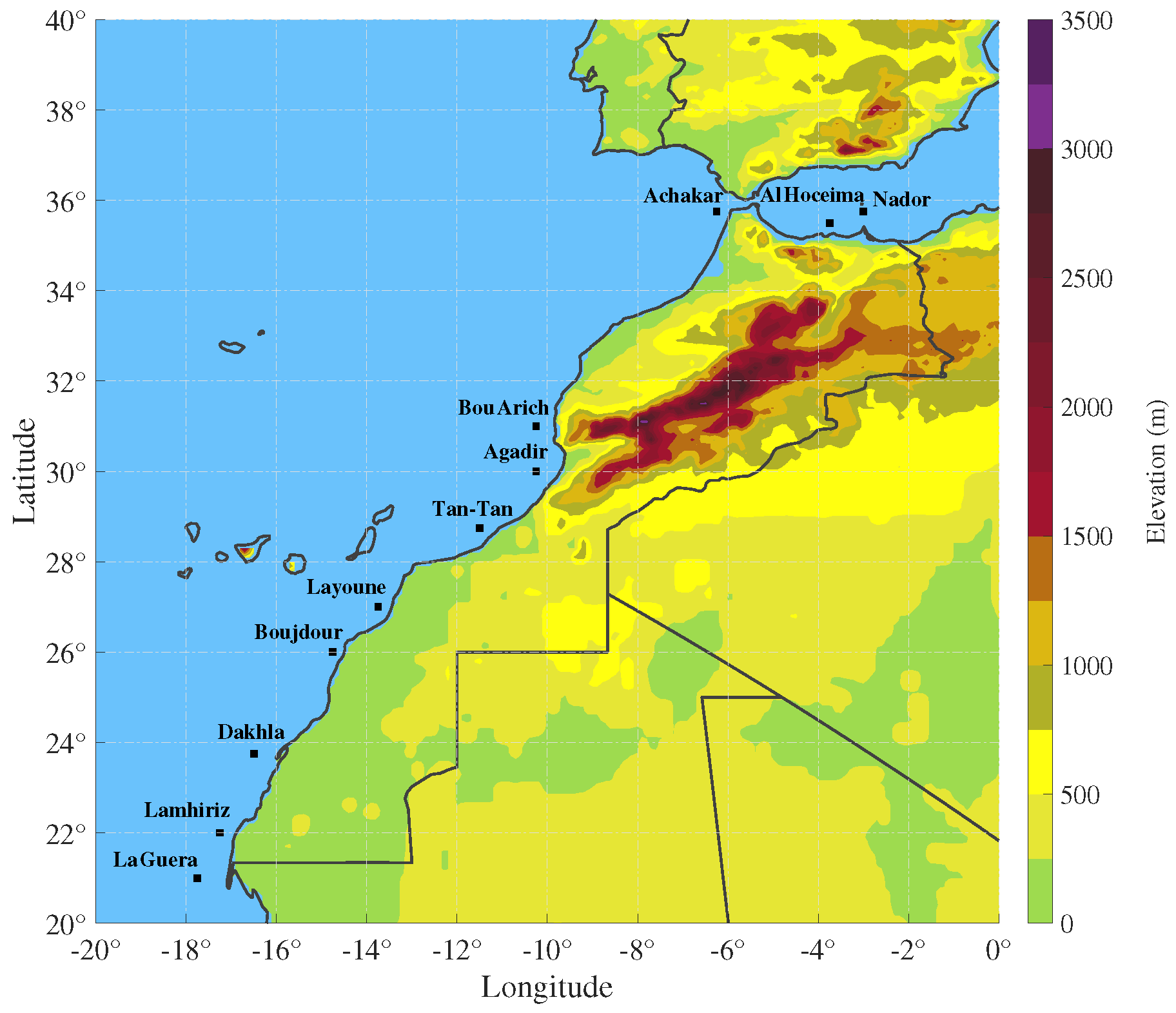
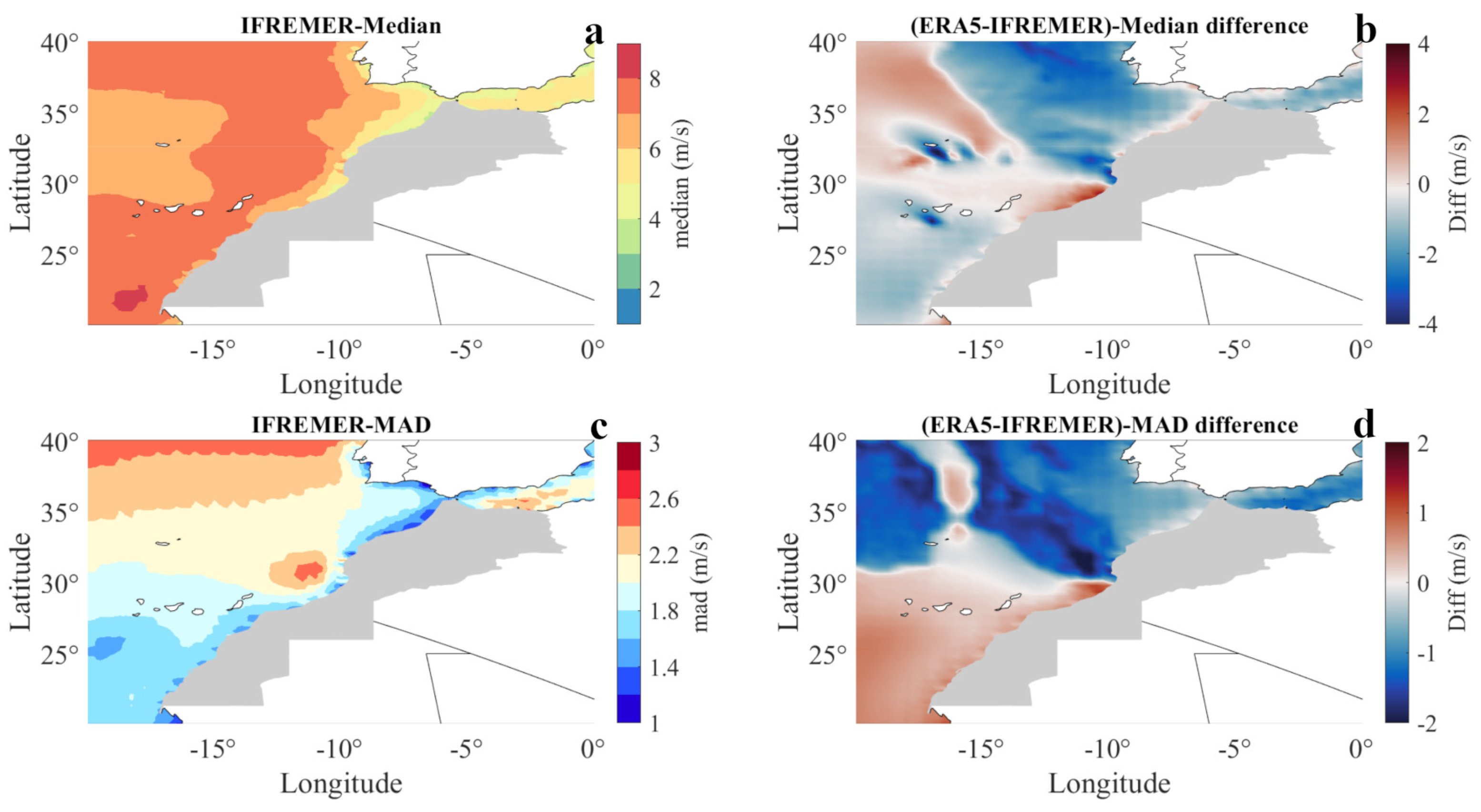

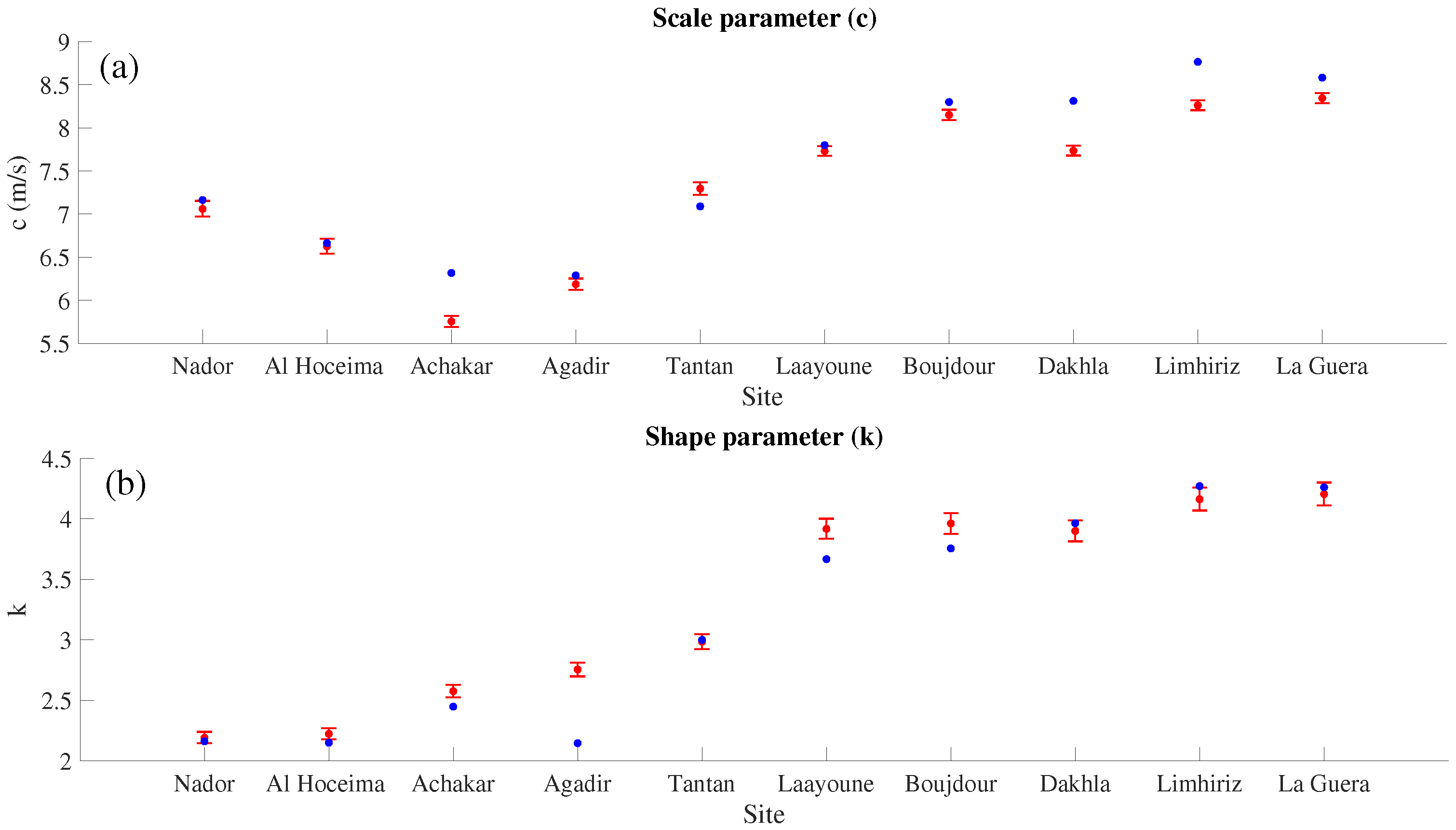
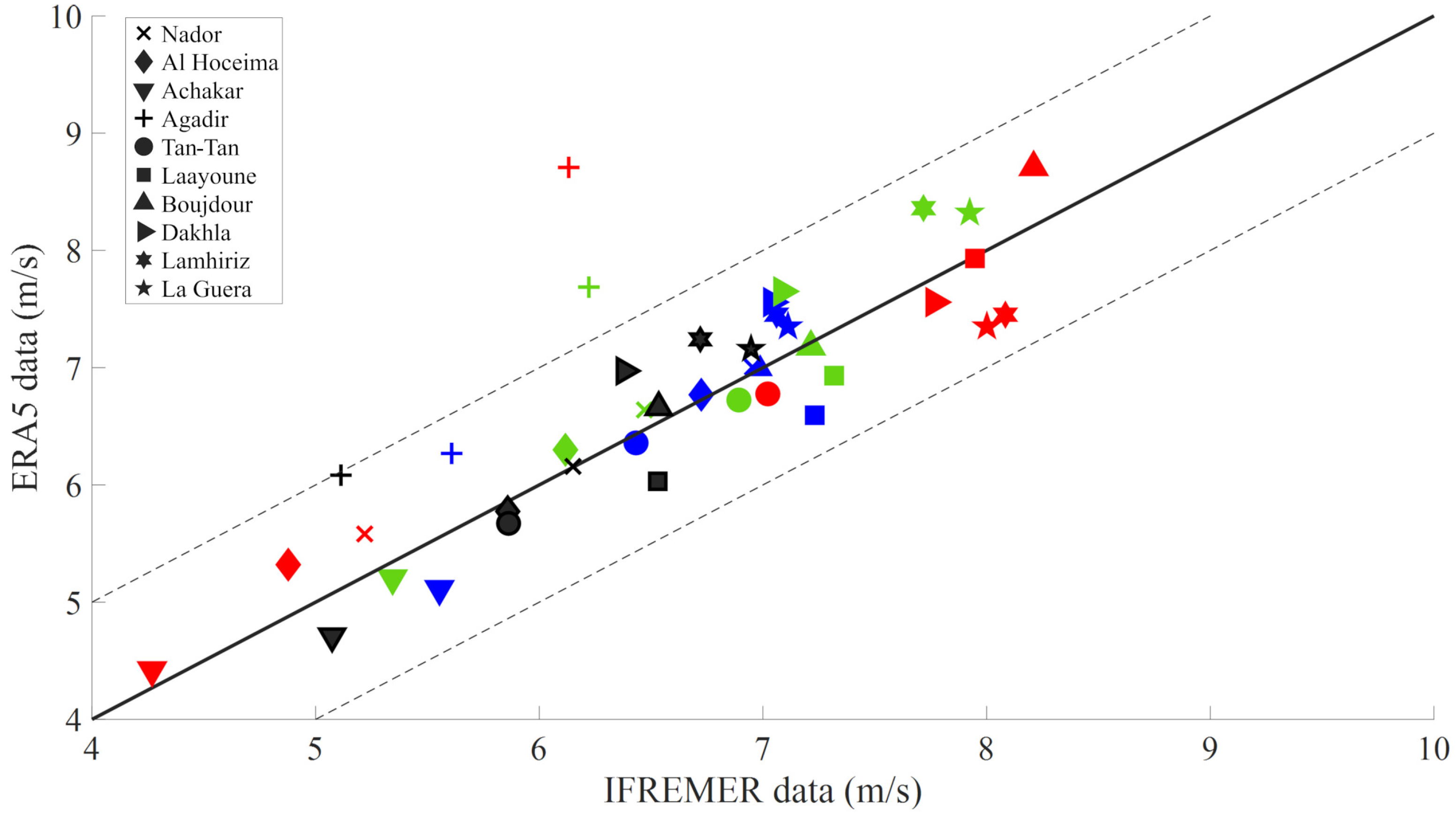

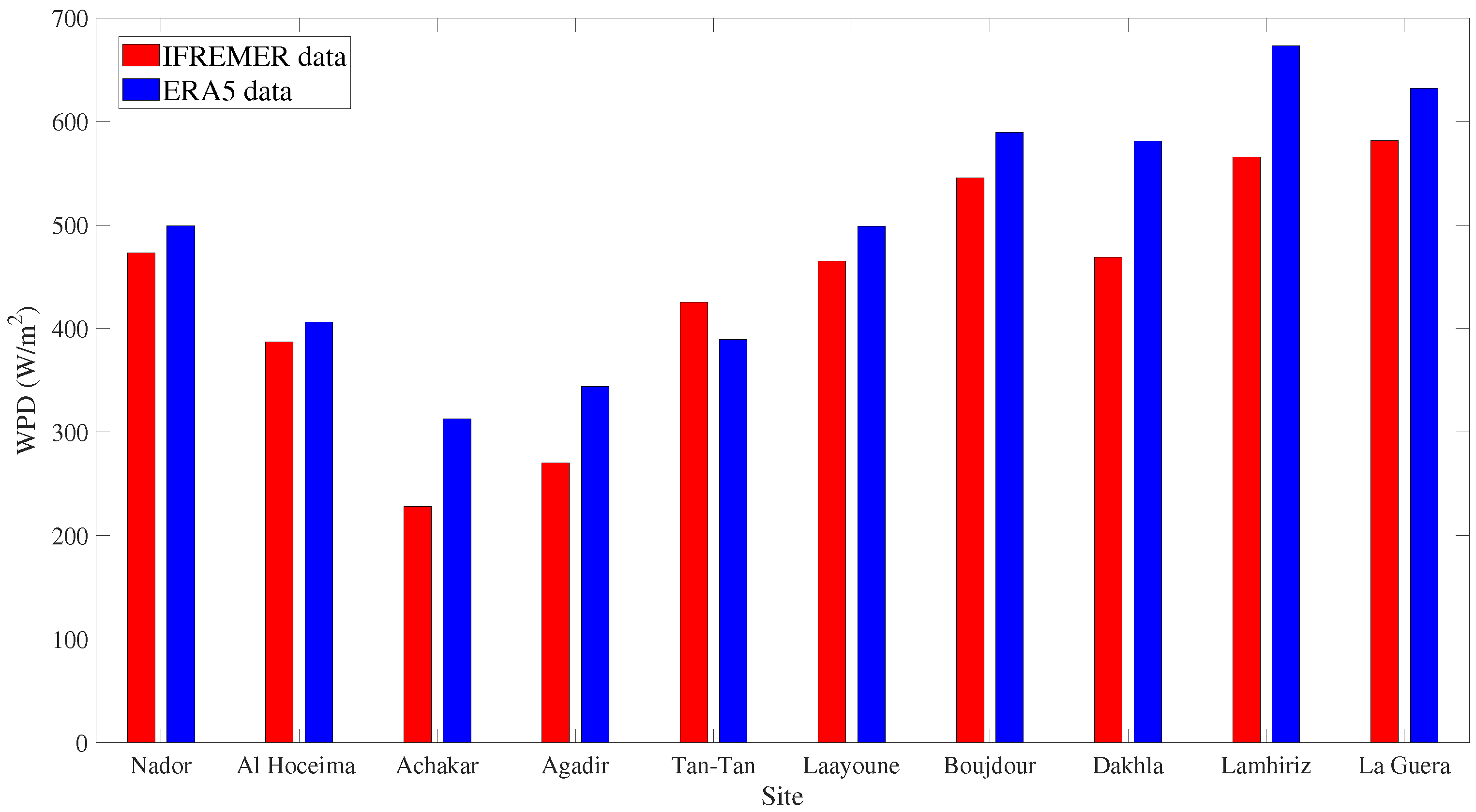
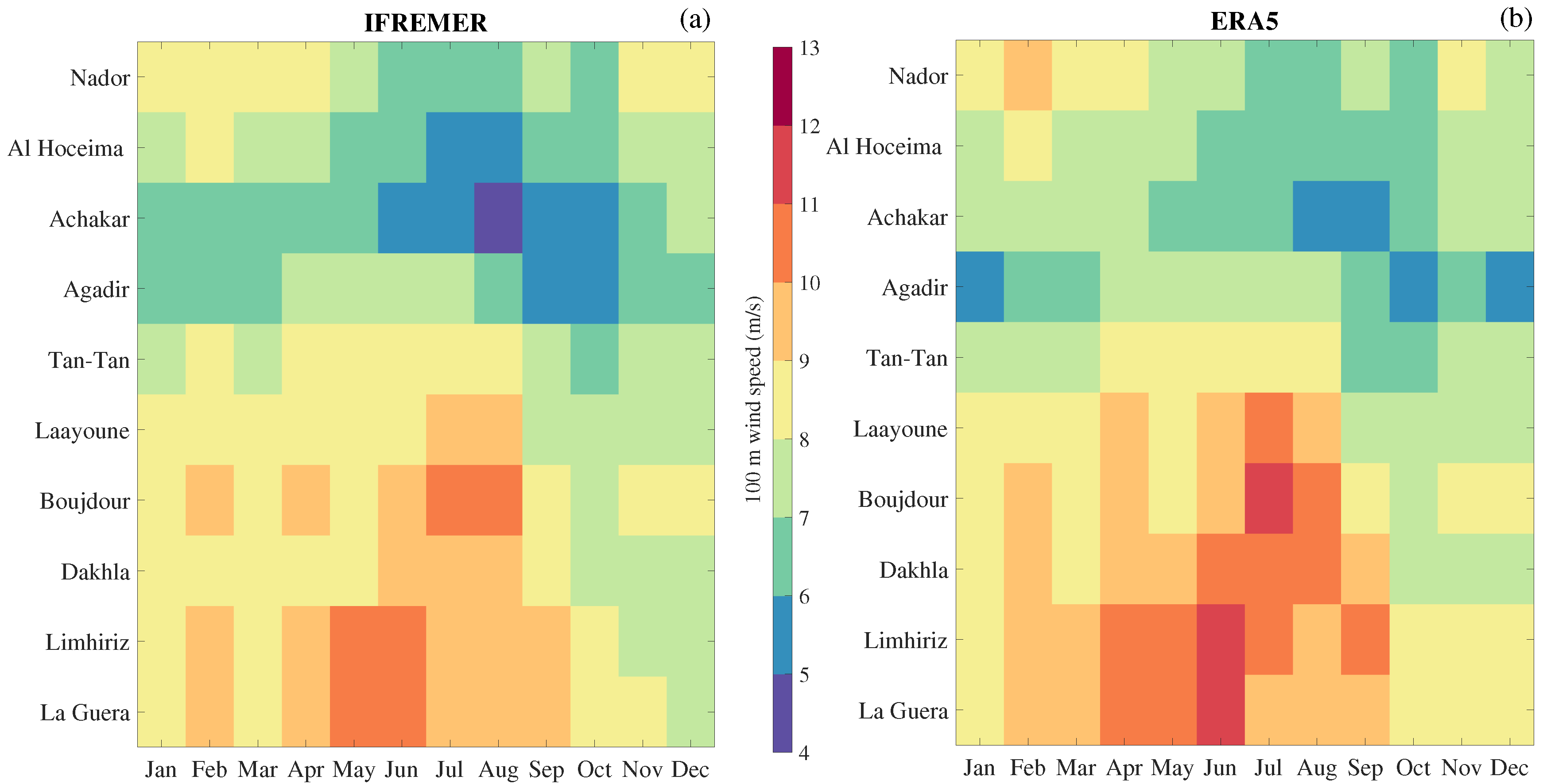


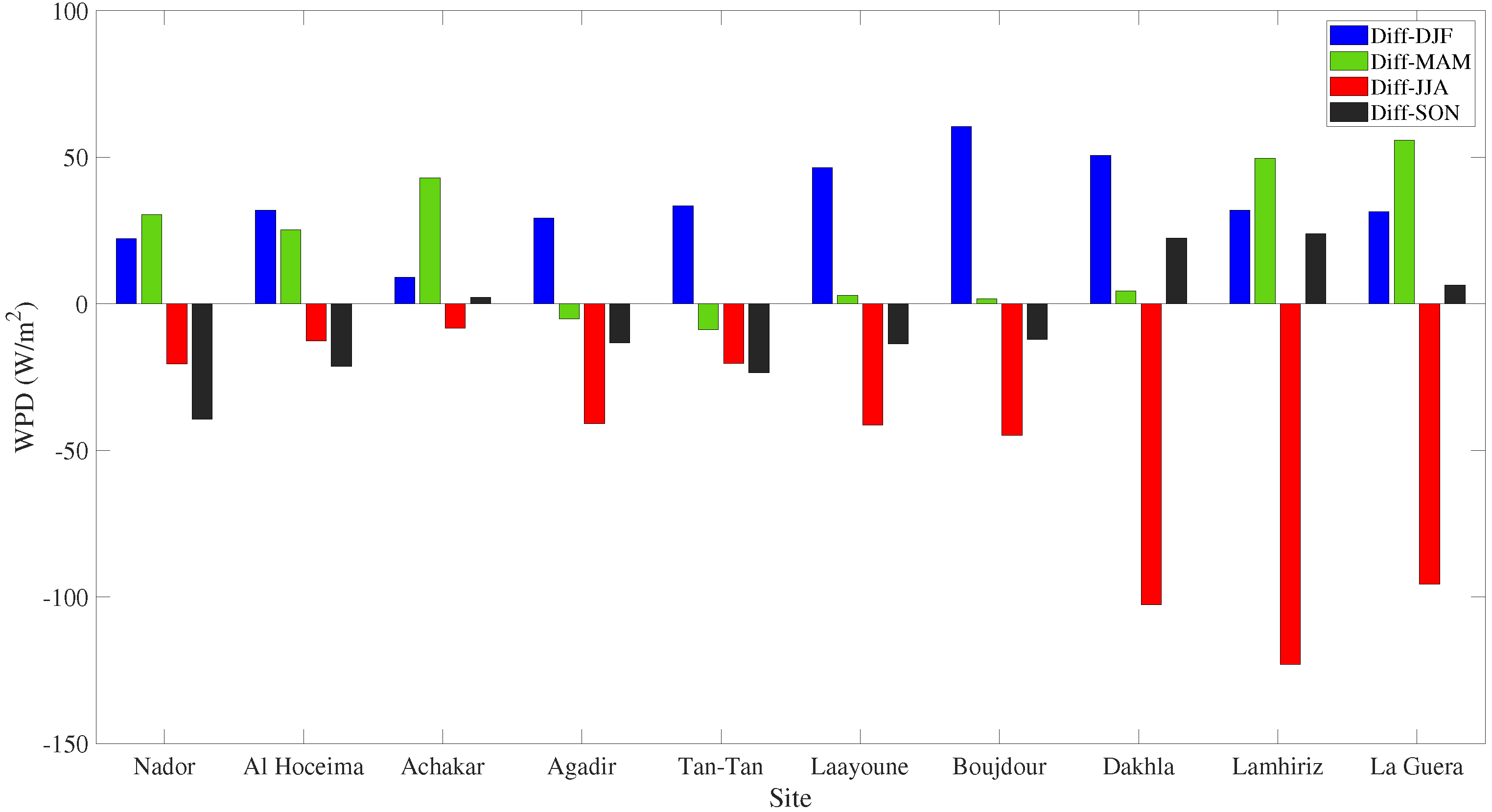
| Site | Data | Mean | SKEW | KU | Percentiles (95%) | Bias | RMSE |
|---|---|---|---|---|---|---|---|
| 1 Nador | Ifremer | 6.23 | 0.66 | 3.05 | 11.24 | +0.09 | 0.92 |
| ERA5 | 6.32 | 0.63 | 2.86 | 12.12 | |||
| 2 Al Hoceima | Ifremer | 5.85 | 0.70 | 3.12 | 11.16 | +0.03 | 1.19 |
| ERA5 | 5.88 | 0.72 | 3.07 | 11.42 | |||
| 3 Achakar | Ifremer | 5.10 | 1.02 | 4.01 | 9.20 | +0.49 | 1.10 |
| ERA5 | 5.59 | 0.91 | 3.42 | 10.40 | |||
| 4 Bou Arich | Ifremer | 6.20 | 0.39 | 2.51 | 10.41 | +1.64 | 2.30 |
| ERA5 | 7.84 | 0.16 | 2.01 | 13.67 | |||
| 5 Agadir | Ifremer | 5.73 | 0.60 | 2.91 | 9.79 | −0.18 | 1.34 |
| ERA5 | 5.55 | 0.81 | 3.25 | 10.88 | |||
| 6 Tan Tan | Ifremer | 6.51 | 0.42 | 2.84 | 10.59 | −0.18 | 0.69 |
| ERA5 | 6.33 | 0.39 | 2.95 | 10.26 | |||
| 7 Layoune | Ifremer | 7.00 | 0.02 | 2.70 | 10.16 | +0.09 | 0.74 |
| ERA5 | 7.09 | −0.11 | 2.58 | 10.48 | |||
| 8 Boujdour | Ifremer | 7.38 | −0.16 | 2.51 | 10.62 | +0.14 | 0.68 |
| ERA5 | 7.52 | −0.22 | 2.55 | 11.02 | |||
| 9 Dakhla | Ifremer | 6.99 | −0.29 | 2.49 | 10.06 | +0.53 | 0.86 |
| ERA5 | 7.52 | −0.42 | 2.62 | 10.71 | |||
| 10 Lamhiriz | Ifremer | 7.49 | −0.45 | 2.54 | 10.48 | +0.48 | 0.79 |
| ERA5 | 7.97 | 0.55 | 2.71 | 11.91 | |||
| 11 La Guera | Ifremer | 7.57 | −0.45 | 2.52 | 10.55 | +0.22 | 0.65 |
| ERA5 | 7.79 | −0.49 | 2.64 | 10.85 |
| Site | Data | Median | MAD | RCoV | YKI | P10% Days (%) | P90% Days (%) |
|---|---|---|---|---|---|---|---|
| 1 Nador | Ifremer | 5.83 | 2.16 | 0.37 | 0.09 | 99 | 83 |
| ERA5 | 5.87 | 2.16 | 0.36 | 0.08 | |||
| 2 Al Hoceima | Ifremer | 5.42 | 1.98 | 0.36 | 0.11 | 91 | 77 |
| ERA5 | 5.54 | 2.15 | 0.39 | 0.10 | |||
| 3 Achakar | Ifremer | 4.64 | 1.23 | 0.26 | 0.19 | 73 | 76 |
| ERA5 | 4.20 | 1.18 | 0.28 | 0.31 | |||
| 4 Bou Arich | Ifremer | 6.01 | 1.89 | 0.31 | 0.04 | 40 | 72 |
| ERA5 | 7.71 | 2.96 | 0.38 | 0.00 | |||
| 5 Agadir | Ifremer | 5.44 | 1.64 | 0.30 | 0.08 | 61 | 77 |
| ERA5 | 6.79 | 2.72 | 0.40 | 0.08 | |||
| 6 Tan Tan | Ifremer | 6.38 | 1.73 | 0.27 | 0.01 | 83 | 85 |
| ERA5 | 6.20 | 1.60 | 0.26 | 0.02 | |||
| 7 Laayoune | Ifremer | 7.05 | 1.40 | 0.20 | −0.03 | 60 | 76 |
| ERA5 | 6.91 | 1.47 | 0.21 | −0.04 | |||
| 8 Boujdour | Ifremer | 7.53 | 1.53 | 0.20 | −0.08 | 58 | 75 |
| ERA5 | 7.47 | 1.59 | 0.21 | −0.04 | |||
| 9 Dakhla | Ifremer | 7.22 | 1.47 | 0.20 | −0.11 | 41 | 40 |
| ERA5 | 7.88 | 1.51 | 0.19 | −0.10 | |||
| 10 Lamhiriz | Ifremer | 7.81 | 1.48 | 0.19 | −0.15 | 40 | 73 |
| ERA5 | 8.28 | 1.49 | 0.18 | −0.14 | |||
| 11 La Guera | Ifremer | 7.90 | 1.50 | 0.19 | −0.16 | 41 | 74 |
| ERA5 | 8.07 | 1.52 | 0.19 | −0.13 |
| Site | Data | Mean | WPD (W/m2) | Wind Power Class | L-W Days (v < 3 m/s) |
|---|---|---|---|---|---|
| 1 Nador | Ifremer | 7.56 | 473 | C3 | 732 |
| ERA5 | 7.67 | 499 | C3 | 763 | |
| 2 Al Hoceima | Ifremer | 7.09 | 387 | C2 | 810 |
| ERA5 | 7.13 | 406 | C2 | 877 | |
| 3 Achakar | Ifremer | 6.19 | 228 | C1 | 436 |
| ERA5 | 6.77 | 313 | C2 | 373 | |
| 5 Agadir | Ifremer | 6.66 | 270 | C2 | 300 |
| ERA5 | 6.73 | 344 | C2 | 947 | |
| 6 Tan Tan | Ifremer | 7.89 | 425 | C3 | 146 |
| ERA5 | 7.67 | 389 | C2 | 230 | |
| 7 Laayoune | Ifremer | 8.49 | 465 | C3 | 40 |
| ERA5 | 8.60 | 499 | C3 | 118 | |
| 8 Boujdour | Ifremer | 8.94 | 545 | C3 | 44 |
| ERA5 | 9.11 | 590 | C4 | 105 | |
| 9 Dakhla | Ifremer | 8.48 | 469 | C3 | 134 |
| ERA5 | 9.12 | 581 | C4 | 157 | |
| 10 Lamhiriz | Ifremer | 9.09 | 506 | C4 | 96 |
| ERA5 | 9.66 | 673 | C5 | 82 | |
| 11 La Guera | Ifremer | 9.18 | 582 | C4 | 78 |
| ERA5 | 9.45 | 632 | C4 | 96 |
Disclaimer/Publisher’s Note: The statements, opinions and data contained in all publications are solely those of the individual author(s) and contributor(s) and not of MDPI and/or the editor(s). MDPI and/or the editor(s) disclaim responsibility for any injury to people or property resulting from any ideas, methods, instructions or products referred to in the content. |
© 2024 by the authors. Licensee MDPI, Basel, Switzerland. This article is an open access article distributed under the terms and conditions of the Creative Commons Attribution (CC BY) license (https://creativecommons.org/licenses/by/4.0/).
Share and Cite
Zekeik, Y.; OrtizBevia, M.J.; Alvarez-Garcia, F.J.; Haddi, A.; El Mourabit, Y.; RuizdeElvira, A. Long-Term Assessment of Morocco’s Offshore Wind Energy Potential Using ERA5 and IFREMER Wind Data. J. Mar. Sci. Eng. 2024, 12, 460. https://doi.org/10.3390/jmse12030460
Zekeik Y, OrtizBevia MJ, Alvarez-Garcia FJ, Haddi A, El Mourabit Y, RuizdeElvira A. Long-Term Assessment of Morocco’s Offshore Wind Energy Potential Using ERA5 and IFREMER Wind Data. Journal of Marine Science and Engineering. 2024; 12(3):460. https://doi.org/10.3390/jmse12030460
Chicago/Turabian StyleZekeik, Younes, Maria J. OrtizBevia, Francisco J. Alvarez-Garcia, Ali Haddi, Youness El Mourabit, and Antonio RuizdeElvira. 2024. "Long-Term Assessment of Morocco’s Offshore Wind Energy Potential Using ERA5 and IFREMER Wind Data" Journal of Marine Science and Engineering 12, no. 3: 460. https://doi.org/10.3390/jmse12030460






